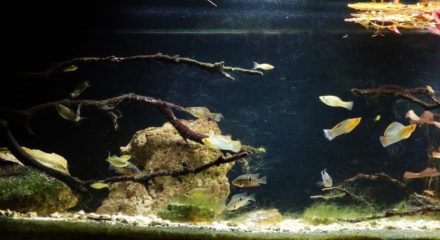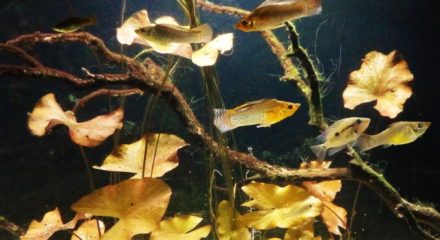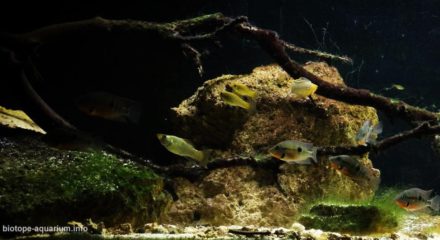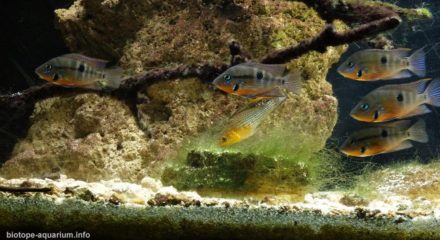Cenote of Dzibilchaltun, Yucatan, Mexico
24th place in Biotope Aquarium Design Contest 2016
![]() Belgium. Jeroen Vanhooren
Belgium. Jeroen Vanhooren
Aquarium Volume: 500 L
Fish and invertebrates: Thorichthys meeki, Poecilia velifera
Plants list: Nymphae sp.
Biotope description: The Cenote of Dzibilchaltun lies in the Yucatán peninsula. Beneath a thin layer of topsoil, the underground of the peninsula is composed of porous limestone, deposited in the shallow oceans during past Ice Ages. This type of geological structure is known as the Karst system. As a result, no rivers are found in the Peninsula. Instead underground streams and caves are formed. Cenotes are sinkholes, that were made by the collapse of limestone rock because of the interaction with groundwater. Some of them have many caves, some of them have a more cylindric form. The water in the cenotes is very hard because of the solution of the limestone (high Ca content – pH 7-8). The cenote of Dzibilchaltun is an older cenote with practically vertical walls. As “wall material” I used tufa-stone (limestone) that makes the water even harder. The only aquatic vegetation consists of large groups of Nymphaea ampla. In the caves of these waterbodies one can find the blind Astyanax mexicanus and blind crayfish. Also livebearers (Poecilia velifera, Gambusia yucatana,…) , cichlids (Thorichthys meeki, Cichlasoma urophthalmus,…) and Rhamdia catfish species live here. As fish I used Poecilia velifera and Thorichthys meeki, who are showing amazing colors. The Poecilia males show off their impressive sailfin during courtship. For the rest of the day they swim in a nice shoal or graze the algae from the tufastone. The wild coloured form is far more beautiful than the more commercial forms. There is no way to create a more beautiful creature than nature did. Sadly enough cenotes (and the Karst system as a whole) are very vulnerable ecosystems. Because of tourist pressure (cenotes are very popular diving areas), bad planning of tourist accommodation and poor water treatment, faecal contamination have been found in different groundwater systems.
Fish and invertebrates: Thorichthys meeki, Poecilia velifera
Plants list: Nymphae sp.
Biotope description: The Cenote of Dzibilchaltun lies in the Yucatán peninsula. Beneath a thin layer of topsoil, the underground of the peninsula is composed of porous limestone, deposited in the shallow oceans during past Ice Ages. This type of geological structure is known as the Karst system. As a result, no rivers are found in the Peninsula. Instead underground streams and caves are formed. Cenotes are sinkholes, that were made by the collapse of limestone rock because of the interaction with groundwater. Some of them have many caves, some of them have a more cylindric form. The water in the cenotes is very hard because of the solution of the limestone (high Ca content – pH 7-8). The cenote of Dzibilchaltun is an older cenote with practically vertical walls. As “wall material” I used tufa-stone (limestone) that makes the water even harder. The only aquatic vegetation consists of large groups of Nymphaea ampla. In the caves of these waterbodies one can find the blind Astyanax mexicanus and blind crayfish. Also livebearers (Poecilia velifera, Gambusia yucatana,…) , cichlids (Thorichthys meeki, Cichlasoma urophthalmus,…) and Rhamdia catfish species live here. As fish I used Poecilia velifera and Thorichthys meeki, who are showing amazing colors. The Poecilia males show off their impressive sailfin during courtship. For the rest of the day they swim in a nice shoal or graze the algae from the tufastone. The wild coloured form is far more beautiful than the more commercial forms. There is no way to create a more beautiful creature than nature did. Sadly enough cenotes (and the Karst system as a whole) are very vulnerable ecosystems. Because of tourist pressure (cenotes are very popular diving areas), bad planning of tourist accommodation and poor water treatment, faecal contamination have been found in different groundwater systems.
Photo Gallery
Comments of the members of the jury of Biotope Aquarium Design Contest 2016

Lovely to see wild type Sailfin mollies.

It is a great effort. Your representation is perfect with correct décor and fishes. You choose to set something that we do not see often and you have implemented it excellently.






